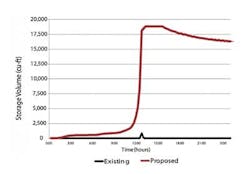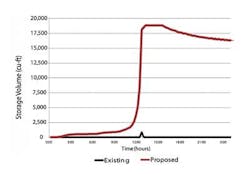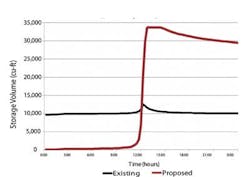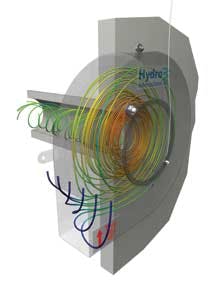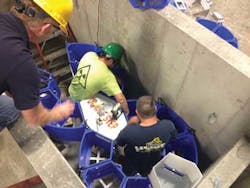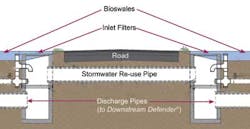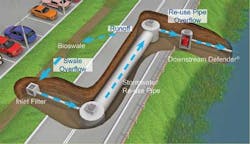Bridging the Gap: Blue Infrastructure Helps Mitigate Rift Between Green, Gray Development
By Bob Andoh
Scourges of flooding are afflicting countries all over the world indiscriminately, whether rich or poor, developed or developing, and myriad media outlets regularly remind us of their ruthless devastation. As such, climate change and the relentless pace of urbanization are together challenging us to reevaluate the resilience of our towns and cities battered with more frequent and intense storm events.
When urban infrastructure is stretched beyond its limits by storms, not only does flooding wreck homes and properties but the resulting diffuse pollution threatens long-term damage to aquatic environments and habitats.
Research in the U.S. has highlighted that stormwater is the leading cause of poor water quality through pollutants in sediment carried in runoff. Further, nutrients and heavy metals of greatest concern tend to be carried in the finer sediment.
Across the world, legislative frameworks are being developed which set challenging ecological targets to improve water quality and manage flood risk more effectively. Fortunately, there are conventional and developing technologies available as well as best-practice methodologies and techniques promoted and shared across the globe. Particularly in developed countries, regulation that enforces sustainable practices for surface water drainage in new developments is advancing.
Retrofitting is the Real Challenge
The real challenge, however, is in retrofitting surface water drainage improvements into existing developments and catchments - particularly highly-urbanized catchments where space is usually at a premium. Space constraints are resulting in a re-evaluation of the role, appropriateness and sustainability of both conventional and emerging green infrastructure approaches to drainage.
The green infrastructure methodology, which encourages the use of natural land and plant-based systems such as ponds, wetlands and rain gardens, is gathering increasing support and exchange of ideas through movements such as low impact development (LID) in the U.S., sustainable drainage systems (SuDS) in the UK and Water Sensitive Urban Design in Australia.
Green infrastructure approaches are favored for their aesthetic contribution to landscape design, as well as potentially providing a public amenity. However, often in tight urban retrofit projects, the space requirements for these projects are simply not feasible on their own.
The Urban Retrofit Toolkit
The challenge is, therefore, to maintain green infrastructure's guiding principle of mimicking natural drainage paths and processes by employing a toolkit of appropriate systems, devices and features. In particular, there are some emerging yet well-proven technologies available to retrofit into the existing urban drainage infrastructure that can be deployed in conjunction with both conventional drainage and emerging green infrastructure to leverage the best of both. Such systems and devices are called blue infrastructure.
Blue infrastructure technologies tend to have the characteristics of being more compact and efficient than their conventional technology surrogates. Likewise, they are also particularly well-suited to retrofit into existing urban infrastructure, or gray infrastructure, and are also effective when used in combination with green infrastructure, serving as either pretreatment systems to improve their efficacy and facilitate maintenance or to provide space-efficient treatment trains.
Recent technological developments in a number of blue infrastructure technologies have facilitated the maximum use of existing urban infrastructure, bridging the gap between traditional gray infrastructure and evolving green infrastructure.
The vortex flow control is one such blue infrastructure technology used to attenuate stormwater and control the flow rate of stormwater runoff through the drainage infrastructure to protect downstream assets from flooding or being overloaded.
The internal geometry of a vortex valve is designed to enable water to flow through without restriction for as long as possible. Then, when the water upstream reaches a pre-determined level, a vortex is triggered in the flow. The vortex creates a core of air in the center that has the effect of throttling back the water and releasing it at a measured and controlled rate to alleviate flooding and prevent downstream systems from becoming inundated.
Expanding Stormwater Capacity
An example of this technology is represented in Schuylerville, N.Y. Installing a vortex flow control device enabled the storage capacity within two retention ponds to be expanded, ending the problem of the ponds discharging flow downhill at high velocities causing land erosion. The solution enabled water to flow unrestricted through the vortex valve during the low-intensity stages of the 25-year storm event, which was the design standard for the Schuylerville ponds.
The installation of the 8-inch vortex flow control allowed more flow to discharge at lower head, leaving more capacity in the pond during the peak storm event. The solution expanded the capacity of the upper pond from 12,500 cubic feet to 33,716 cubic feet, and the lower pond from 832 cubic feet to 18,851 cubic feet. The vortex valve discharges at a controlled rate into a new storm drain that runs through the center of town before being discharged into a canal along the Hudson River.
Knowledge Transfer Partnership
A project involving academia and industry in the UK through a knowledge transfer partnership (KTP) has led to the evolution of a new type of vortex flow control. This union between Exeter University and Hydro International was awarded the highest grade of "outstanding" by the KTP grading panel. It involved the use of computational fluid dynamics (CFD) and physical testing of prototypes to understand the underlying fluid dynamics and interactions between the physical variables and the hydraulic performance and behavior of the device.
The project enabled the hydraulic behavior of the device to be optimized and tailored to maximize stormwater storage benefits. The design optimization process enables the vortex flow control to be tailored to suit a customer's specific design objectives and requirements. In North America, this vortex flow control is known as the Reg-U-Flo® Vortex Valve.
Another blue infrastructure technology for retrofit is a compact, modular, passive, high-capacity upflow stormwater filtration system that was initially developed under the Environmental Protection Agency's (EPA) Small Business Innovative Research (SBIR) program by researchers at the University of Alabama.
The system, commercialized as the Up-Flo® Filter, incorporates multiple elements of a treatment train - screening, sedimentation and high-rate filtration - in a single device that uses a sedimentation sump and screening system to pretreat stormwater runoff before it flows through the filter media where final filtration occurs.
A simple modular cross-piece flow conveyance component was developed for the device and first applied on a project in New Rochelle, N.Y. The cross-piece enabled adjacent 6-module filter units to be connected together in a way that eliminated the need for separate outlet modules. This resulted in the 18 filter modules fitting into a chamber that was only 14 feet (4.2 meters) by 4 feet (1.2 meters) in size - a 50 percent reduction in footprint.
A final example of the innovative combination of green infrastructure features and innovative blue infrastructure technology in an urban retrofit setting is represented in Englewood, Fla. An LID pilot scheme was implemented to upgrade the stormwater infrastructure and protect the integrity of the water quality discharging into the local Lemon Bay Aquatic Preserve. A number of stormwater best management practices (BMPs) were designed as part of a treatment train system - particularly bioswales where engineered soil media provide a high level of treatment for road and roof runoff.
During more intense storm events, excess runoff flows directly into a discharge pipe network, which also enables water reuse for irrigation of nearby properties. When it exceeds its storage capacity, excess flow is conveyed into an advanced vortex separator for final treatment. A second separator is installed nearby to treat runoff from a more heavily-trafficked area; both ensure high water quality discharge into Lemon Bay.
Conclusion
The examples of blue infrastructure described demonstrate how these technologies can serve as a bridge between the traditional gray infrastructure and the evolving green infrastructure. Further, they provide a means to mitigate the adverse impacts of urbanization in a space-efficient manner whilst making best possible use of the existing urban infrastructure. In an urban retrofit setting, such technologies are essential as part of a wider toolbox of solutions for integrated urban water management that can be designed to meet a site's specific requirements.
